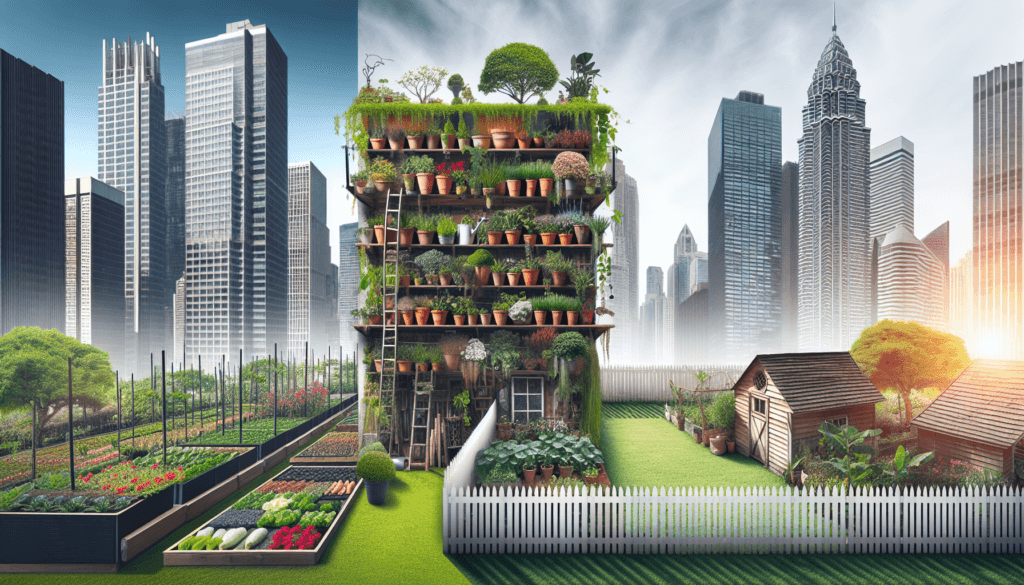Urban gardening and normal gardening may seem similar at first glance, but there are key differences that set them apart. In urban gardening, space constraints often require creative solutions such as vertical gardening or rooftop gardens, whereas traditional gardening takes place in more spacious suburban or rural areas. Additionally, urban gardening tends to focus on growing plants in containers or raised beds, making it easier to maintain and control the environment. This article explores the distinct aspects of urban gardening, shedding light on its unique challenges and benefits. Whether you’re a seasoned gardener or just curious about exploring this urban phenomenon, read on to discover how you can become a thriving urban gardener.
Space
Size of the garden
Urban gardening often takes place in limited spaces, such as small backyard gardens, balconies, rooftops, or even indoor areas. Unlike traditional gardening, where there may be ample space to grow plants, urban gardening requires a thoughtful approach to maximize the available area.
Types of spaces used
In urban gardening, any available space can be utilized for growing plants. This includes vertical spaces, such as walls or trellises, where climbers or vines can be grown. Other common types of spaces used in urban gardening include container gardening, raised beds, hanging planters, or even hydroponic systems. The use of various spaces allows for flexibility and creativity in designing an urban garden.
Utilization of vertical space
With limited ground space, urban gardening relies heavily on utilizing vertical space. Vertical gardening techniques, such as trellises, wall-mounted planters, or hanging baskets, make efficient use of space by allowing plants to grow upwards. This not only maximizes the available area but also adds visual interest and makes the most out of limited square footage.
Container gardening
Container gardening is a popular method in urban gardening due to its versatility and ease of use. Containers come in various sizes and can be placed on balconies, windowsills, or even on rooftops. This allows gardeners to have control over the soil quality, water management, and plant selection. Container gardening is particularly useful in urban environments where the soil may be of poor quality or contaminated.
Location
Availability of land
One significant difference between urban gardening and traditional gardening is the availability of land. In urban areas, the availability of open land for gardening is often limited, making it necessary to find alternative spaces or creative solutions for gardening.
Access to sunlight
Another crucial factor to consider in urban gardening is access to sunlight. Buildings, trees, and other structures may cast shadows on the garden, limiting the amount of direct sunlight plants receive. Gardeners must carefully assess the available sunlight in their chosen location and select plants that thrive in varying degrees of shade or consider supplemental lighting methods if necessary.
Proximity to pollution
Urban environments often come with increased levels of pollution from traffic, industrial activities, or air pollutants. It is essential to consider the proximity of the garden to potential sources of pollution, as these can have adverse effects on plant health. Plant selection and regular maintenance may need to be adjusted to mitigate the impact of pollution on the garden.
Noise and urban environment factors
Urban environments can be noisy, with sounds from traffic, construction, or other urban activities. These noise factors can impact not only the gardener’s experience but also plant growth. Some plants may be more tolerant of noise, while others may be affected by it. Urban gardeners should consider noise levels and choose plants that can thrive in such conditions.

Design and Planning
Maximizing limited space
Designing an urban garden requires careful consideration of space management. Utilizing vertical gardening techniques, such as trellises or hanging planters, can maximize the use of limited space. Additionally, planning the layout with efficiency in mind, such as grouping plants with similar light and water needs, can make the most of the available area.
Creative use of containers and raised beds
In urban gardening, containers and raised beds are valuable tools for creative design. Containers can be arranged strategically to create an aesthetically pleasing display or to optimize space utilization. Raised beds can be built on balconies or rooftops, providing an opportunity to grow plants in areas where the soil quality is poor or nonexistent.
Consideration of aesthetics in a limited area
Even with limited space, aesthetics can play a significant role in urban gardening. By carefully selecting plants with different colors, textures, and growth habits, urban gardeners can create visually appealing landscapes. Incorporating elements such as ornamental structures, artistic plant arrangements, or creative pathways can enhance the overall aesthetic appeal of the garden.
Adapting to urban landscape challenges
Urban landscapes present unique challenges such as limited soil, drainage issues, or restricted access to natural resources. Urban gardeners must adapt their gardening practices to overcome these challenges. Techniques like using raised beds, container gardening, or implementing efficient irrigation systems can help address these obstacles and ensure successful gardening in urban areas.
Water Management
Limited water availability in urban areas
Water scarcity is a common issue in urban areas, making efficient water management crucial in urban gardening. Urban gardeners must be mindful of their water usage and adopt practices that minimize wastage. This can include collecting rainwater, using drip irrigation systems, and employing watering techniques that target the root zone of plants.
Rainwater harvesting techniques
Rainwater harvesting is an excellent method for urban gardeners to conserve water. By collecting rainwater in barrels or containers, gardeners can rely less on municipal water sources and reduce their ecological footprint. Rainwater can be used for watering plants, reducing water bills, and promoting sustainability in urban gardening.
Drip irrigation systems
Drip irrigation systems are highly efficient and effective in urban gardening. These systems deliver water directly to the roots of plants, minimizing evaporation and water waste. Drip irrigation not only conserves water but also provides plants with a consistent and controlled water supply. This ensures optimal plant growth and minimizes the risk of overwatering or underwatering.
Water-efficient practices
Water-efficient practices, such as mulching, can help urban gardeners save water. Mulching is the process of covering the soil surface with organic materials or mulch, which acts as a barrier, reducing evaporation and retaining soil moisture. Additionally, by grouping plants with similar water needs together, gardeners can use water more efficiently and avoid overwatering or underwatering specific plants.

Plant Selection
Choosing plants suitable for urban conditions
The choice of plants in urban gardening should consider the unique conditions of an urban environment. Plants selected should be able to tolerate pollution, limited space, and varying sunlight levels. Native or adapted plant species are often well-suited for urban conditions, as they are more resilient to local environmental challenges.
Selection based on available space and lighting
Urban gardeners must consider the available space and lighting conditions when choosing plants. Compact and dwarf varieties are excellent choices for small spaces, as they require less room to grow. Additionally, plants that thrive in partial shade or shade are suitable for areas with limited direct sunlight. Careful selection based on these factors ensures that plants will thrive in the given urban environment.
Using compact and dwarf varieties
Compact and dwarf varieties of plants are ideal for urban gardening due to their smaller size. These plants take up less space but still offer bountiful harvests or ornamental beauty. They are well-suited for containers, raised beds, or vertical gardening structures. Urban gardeners can enjoy a diverse range of plants even in limited spaces by opting for these smaller varieties.
Edible ornamentals for dual-purpose gardening
Edible ornamental plants are a popular choice in urban gardening as they provide both beauty and sustenance. These plants offer attractive foliage, flowers, or fruits, adding aesthetic value to the garden. Additionally, they can be harvested and consumed, providing fresh food for urban gardeners. Edible ornamentals are a smart choice for dual-purpose urban gardening.
Soil Considerations
Quality of urban soil
Urban soil often faces challenges such as poor quality, contamination, or lack of organic matter. Urban gardeners should assess the quality of their soil before planting and make necessary amendments to ensure healthy plant growth. Soil tests, organic matter additions, and pH adjustments can help improve the overall quality and fertility of urban soil.
Remediation techniques for contaminated soil
Contaminated soil in urban areas can pose risks to plants and human health. Urban gardeners should be aware of potential soil contaminants, such as heavy metals or pollutants, and take measures to remediate the soil if needed. Techniques like phytoremediation, which use specific plants to remove toxins from the soil, can be employed to address contaminated soil issues.
Amending soil in containers
Container gardening allows urban gardeners to have control over the soil composition. It is essential to choose the right soil mix for containers, ensuring proper drainage and nutrient availability. Urban gardeners can amend container soil with organic matter such as compost or peat moss, making the soil more fertile and providing a suitable growing medium for plants.
Importance of organic matter and composting
In the limited space of urban gardens, it is crucial to maximize soil health. Utilizing organic matter, such as compost or well-rotted manure, improves soil structure, fertility, and water retention. Composting kitchen scraps or yard waste is a sustainable practice that can provide a nutrient-rich soil amendment, reducing the need for chemical fertilizers and promoting environmentally friendly gardening.

Community Gardening
Shared gardening spaces
Community gardening provides an excellent opportunity for urban gardeners to come together and create shared spaces for gardening. These shared spaces can be community gardens, allotment gardens, or shared rooftop gardens. In these spaces, individuals or groups can cultivate their own plots while sharing resources, knowledge, and experiences with fellow gardeners.
Collaboration and communal initiatives
Community gardening encourages collaboration and communal initiatives. Gardeners can work together to maintain shared spaces, organize workshops or events, and collectively address challenges or solve problems. This collaborative approach creates a sense of community and belonging, fostering friendships and social connections within the urban gardening community.
Social benefits and sense of belonging
Urban gardening offers significant social benefits by providing a sense of belonging and connection to the natural environment. Participating in community gardening activities can combat social isolation, promote mental well-being, and create opportunities for social interaction. Urban gardeners often report a greater sense of purpose, satisfaction, and community engagement through their gardening experiences.
Education and skill-sharing opportunities
Community gardens provide a rich learning environment for urban gardeners of all ages and skill levels. Individuals can learn from experienced gardeners, participate in workshops or educational programs, and acquire valuable gardening skills. These skill-sharing opportunities empower individuals to become more self-reliant, promote sustainable practices, and contribute to their local communities.
Pest and Disease Management
Unique challenges in urban environments
Urban environments present unique challenges when it comes to pest and disease management. Urban gardens may face increased pest pressure due to the proximity of other gardens, green spaces, or sources of pests. Additionally, urban areas often have a higher concentration of pests like rats or pigeons, requiring specialized pest management techniques.
Integrated Pest Management (IPM) methods
Integrated Pest Management (IPM) is an environmentally sustainable approach to pest management that focuses on preventing and managing pests through a combination of techniques. IPM methods include cultural practices, biological control, mechanical or physical control, and the responsible use of pesticides only when necessary. This holistic approach minimizes the use of chemicals and promotes long-term pest control.
Organic and non-toxic solutions
Many urban gardeners prefer organic and non-toxic solutions for pest and disease management. These solutions include using natural predators or beneficial insects, applying organic pesticides or botanicals, or using non-toxic barriers like netting or row covers. By choosing these alternatives, urban gardeners can protect their plants while minimizing the impact on human health and the environment.
Utilizing beneficial insects and companion planting
Beneficial insects, such as ladybugs or predatory wasps, can play a vital role in controlling pests in urban gardens. Introducing these beneficial insects or encouraging their presence through companion planting can help naturally reduce pest populations. Companion planting, where certain plants are grown together to enhance pest resistance, can further support pest control efforts in an urban garden.

Regulations and Permits
Understanding local guidelines
Urban gardeners must be aware of and comply with local guidelines, regulations, and restrictions related to gardening. These guidelines may include restrictions on the use of certain chemicals, limitations on structural modifications, or regulations regarding the maintenance of shared spaces. Understanding and adhering to these guidelines is essential for a successful, legal, and sustainable urban gardening practice.
Obtaining necessary permits
In some urban areas, obtaining permits may be necessary for certain gardening activities. This can include permits for installing structures like raised beds or greenhouses, using public spaces for community gardening, or selling produce in urban markets. Urban gardeners should inquire with local authorities or community organizations to determine the necessary permits and comply with regulations in their area.
Complying with zoning and building codes
Zoning regulations and building codes may influence the design and implementation of urban gardens. These regulations dictate where and how gardening activities can take place within the urban landscape. Urban gardeners should be familiar with the zoning and building codes in their area to ensure compliance and avoid potential legal issues or penalties.
Addressing potential safety concerns
Safety is an important consideration in urban gardening, particularly in shared spaces or areas frequented by the public. Gardeners should assess potential safety concerns, such as tripping hazards, structural stability, or exposure to harmful substances. Addressing these concerns, implementing proper signage, and maintaining a safe gardening environment is crucial for the well-being of gardeners and visitors alike.
Economic Considerations
Cost of urban gardening
Urban gardening can be a cost-effective hobby or endeavor, depending on individual preferences and goals. While initial costs may be involved in setting up the garden, such as purchasing containers, soil, or gardening tools, ongoing expenses can be minimized. Many urban gardeners choose to save money by starting plants from seeds, composting kitchen waste, or sharing resources through community gardening initiatives.
Affordability of necessary supplies
Urban gardening supplies, such as containers, potting soil, or seeds, are often readily available and affordable in urban areas. Many garden centers, nurseries, or even local supermarkets offer a variety of gardening supplies at reasonable prices. Additionally, recycling and reusing materials, such as repurposing containers or using compost, can further reduce costs while maintaining a sustainable gardening practice.
Balancing benefits and expenses
Urban gardeners must balance the costs of gardening with the benefits they derive from their garden. For many, the satisfaction of growing their own food, the joy of connecting with nature, or the mental and physical well-being gained from gardening outweigh the expenses. By considering the overall value and benefits derived from urban gardening, individuals can make informed decisions regarding their investments in their gardens.
Potential income generation through urban farming
Urban gardening can go beyond personal enjoyment and become an income-generating activity. Urban farmers may choose to sell their produce at local farmers’ markets, restaurants, or through community-supported agriculture programs. Additionally, providing gardening services, such as designing and maintaining urban gardens for others, can be a source of income for experienced urban gardeners. The potential for income generation in urban farming can further contribute to the economic sustainability of urban gardening practices.
In conclusion, urban gardening offers a unique and fulfilling gardening experience despite the challenges of limited space, pollution, and urban constraints. By maximizing available space, utilizing vertical gardening techniques, and adapting to urban environments, urban gardeners can enjoy the benefits of gardening while contributing to sustainable and resilient communities. With careful consideration of factors such as water management, plant selection, soil quality, and pest control, urban gardening can thrive in any urban landscape. Community gardening initiatives provide opportunities for collaboration, education, and social engagement, fostering a sense of belonging and cultivating a greener and more connected urban society. While regulations and economic considerations play a role, the joy, satisfaction, and potential income-generation possibilities make urban gardening a rewarding venture for individuals and communities alike.



